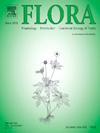北方热带雨林中极度濒危的蓝藻--重新引入的 Erioderma pedicellatum (Hue) P.M.Jørg. 的生长和适应动态
IF 1.8
4区 生物学
Q3 ECOLOGY
引用次数: 0
摘要
这项研究的重点是极度濒危的有性繁殖蓝藻 Erioderma pedicellatum。该物种的减少主要归因于栖息地的丧失和灭绝债务。研究的目的是了解通过移植重新引入杉木(Picea abies (L.) H.Karst.)的可能性,并深入了解该物种对其北方雨林栖息地环境梯度的生长反应。Pedicellatum 的源种群生长在瀑布喷水区内开阔、暴露在阳光下的云杉枝条上,在移植到雨林后发生了显著的环境变化。这种转变引起了荫蔽适应,其特点是最大光系统 II 效率(FV/FM)增加、叶片厚度减少和表观电子传输速率(ETRapp)降低。然而,随机破碎影响了 57% 的植株,造成了重大损失,尤其是在具有大量皮孔的部分,这表明生长和繁殖之间存在权衡。相对生长率(RGR)为正值的未破碎铊表现出与基础阳离子可用性(土壤和树皮 pH 值高)和光照可用性相关的生长增加。在雨林中,一开始就已适应遮荫(高光照下的低 ETRapp)的毛鳞茎生长速度最快。未分化毛丛的最佳子集回归模型占 RGR 变异的 72.8%。将E. pedicellatum重新引入北方雨林是可能的,但具有挑战性,因为在潮湿的树冠层中,光照充足、基阳离子含量高的云杉枝条很少见。本文章由计算机程序翻译,如有差异,请以英文原文为准。
Growth and acclimation dynamics in reintroduced Erioderma pedicellatum (Hue) P.M.Jørg., a critically endangered cyanolichen in boreal rainforest
This study focuses on the critically endangered Erioderma pedicellatum, a sexually reproducing cyanolichen. The species’ decline is primarily attributed to habitat loss and extinction debts. The aim is to understand the possibilities of reintroduction via transplantation on Picea abies (L.) H.Karst. and gain insights into the species' growth response to environmental gradients in its boreal rainforest habitat. The source population of E. pedicellatum found on open, sun-exposed spruce branches within a waterfall spray zone, underwent a significant environmental shift when transplanted to the rainforest. The shift induced shade acclimation, which was marked by an increased maximal photosystem II efficiency (FV/FM), reduced thallus thickness and reduced apparent electron transport rate (ETRapp). However, stochastic fragmentation impacted 57 % of thalli, causing significant losses, particularly in sections with numerous apothecia, suggesting a trade-off between growth and reproduction. Unfragmented thalli with positive relative growth rate (RGR) exhibited increased growth correlated with base cation availability (high soil and bark pH) and light availability. Thalli that were already shade-adapted at the start (low ETRapp at high light) displayed the fastest growth in the rainforest. The best subset regression model of unfragmented thalli accounted for 72.8 % of the variation in RGR. The reintroduction of E. pedicellatum into the boreal rainforest is possible, but challenging, given that well-lit spruce branches with high base cation availability in humid canopy layers are rare.
求助全文
通过发布文献求助,成功后即可免费获取论文全文。
去求助
来源期刊

Flora
生物-植物科学
CiteScore
3.30
自引率
10.50%
发文量
130
审稿时长
54 days
期刊介绍:
FLORA publishes original contributions and review articles on plant structure (morphology and anatomy), plant distribution (incl. phylogeography) and plant functional ecology (ecophysiology, population ecology and population genetics, organismic interactions, community ecology, ecosystem ecology). Manuscripts (both original and review articles) on a single topic can be compiled in Special Issues, for which suggestions are welcome.
FLORA, the scientific botanical journal with the longest uninterrupted publication sequence (since 1818), considers manuscripts in the above areas which appeal a broad scientific and international readership. Manuscripts focused on floristics and vegetation science will only be considered if they exceed the pure descriptive approach and have relevance for interpreting plant morphology, distribution or ecology. Manuscripts whose content is restricted to purely systematic and nomenclature matters, to geobotanical aspects of only local interest, to pure applications in agri-, horti- or silviculture and pharmacology, and experimental studies dealing exclusively with investigations at the cellular and subcellular level will not be accepted. Manuscripts dealing with comparative and evolutionary aspects of morphology, anatomy and development are welcome.
 求助内容:
求助内容: 应助结果提醒方式:
应助结果提醒方式:


